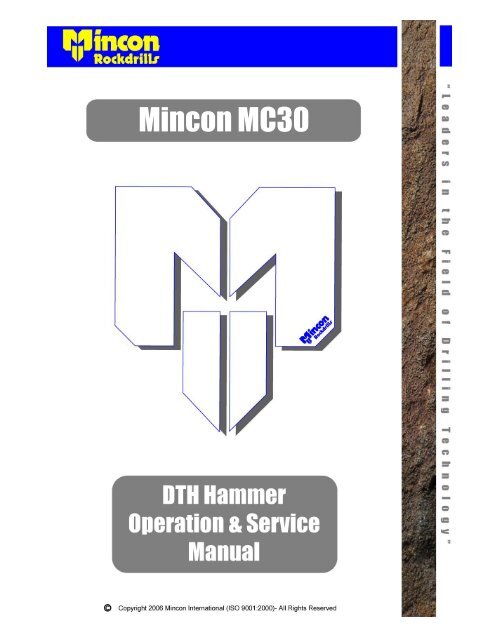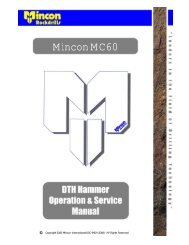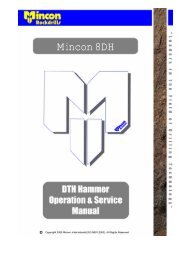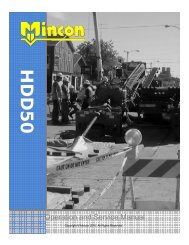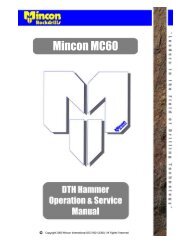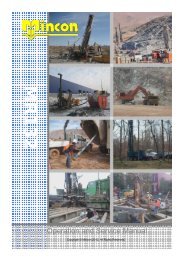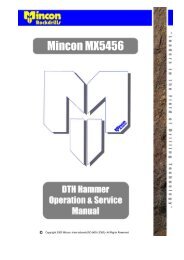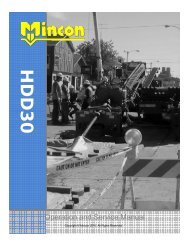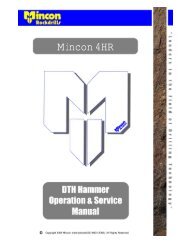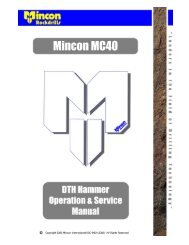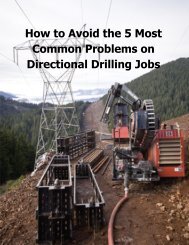Mincon MC30
Mincon MC30
Mincon MC30
You also want an ePaper? Increase the reach of your titles
YUMPU automatically turns print PDFs into web optimized ePapers that Google loves.
<strong>Mincon</strong> <strong>MC30</strong>
Table of Contents1. INTRODUCTION .................................................................................................................................. 32. INSTALLATION AND OPERATION ..................................................................................................... 32.1 SAFETY ................................................................................................................................................................... 32.2 HAMMER CARE. ....................................................................................................................................................... 32.2.1 Storage ............................................................................................................................................................ 32.2.2 Commissioning................................................................................................................................................ 32.2.3 Lubrication ....................................................................................................................................................... 32.2.4 Operation ........................................................................................................................................................ 42.3 SERVICING .............................................................................................................................................................. 42.3.1 General ........................................................................................................................................................... 42.3.2 Opening Chuck and Backhead ....................................................................................................................... 52.3.3 Dismantling Hammer to Change Drill Bit ........................................................................................................ 52.3.4 Disassembly for Full Servicing of Hammer ..................................................................................................... 52.3.5 Inspection ........................................................................................................................................................ 52.3.6 Checking Wear Limits ..................................................................................................................................... 62.3.7 Reassembly .................................................................................................................................................... 63. TROUBLE SHOOTING ........................................................................................................................ 74. APPENDIX ........................................................................................................................................... 84.1 DTH HAMMER EXPLODED VIEW AND PARTS LIST AND TECHNICAL DATA .................................................................... 84.2 HAMMER SERVICE LOG ............................................................................................................................................ 95. WARRANTY ...................................................................................................................................... 10<strong>Mincon</strong> Rockdrills – “The Driller’s Choice” Page 2
1. IntroductionThank you for choosing the <strong>Mincon</strong> <strong>MC30</strong> Down-the-Hole hammer. Please read this manual carefully before using your hammer inthe interests of safety, warranty and best operational care. The <strong>Mincon</strong> <strong>MC30</strong> is ruggedly built with a hardened wear sleeve towithstand the stresses of drilling in the most extreme conditions. However, on the inside it is a precision tool with care taken inmanufacture to ensure that the components meet finely matching tolerances to provide fast drilling, reliability and efficient use of airwithout waste. With correct care your <strong>Mincon</strong> <strong>MC30</strong> hammer should provide you with top performance reliability and long servicelife.Warranty is provided by <strong>Mincon</strong> as per the warranty section 5.Please keep this instruction manual as a permanent part of your DTH Hammer.The specifications and instructions contained in this manual are based on the up-to-date information as at publication date.2. Installation and Operation2.1 SafetyBe sure to work safely at all times. Wear protective clothing and safety equipment and observe all safety regulations as prescribedby your employer, Government, or the site on which you work. Do not wear loose clothing that may get caught in rotating parts andcause serious personal injury.Remember that a “Down-the-Hole” percussive hammer emits noise and you should therefore take every precaution to safeguardyour hearing against damage by using proper ear protectors. Use eye protection at all times. Rock chips and dust which may bedischarged from the face of the bit or bore hole at high velocities and can cause severe injury.Hammers can be heavy – Always use proper and approved lifting equipment and take every precaution to safeguard yourselfagainst injury. Keep hands clear at all times – Beware of getting fingers trapped between the chuck and bit and do not use hands orfeet to clear the top of the borehole at any time.Other safety advice is given throughout this document which you are advised to read.2.2 Hammer Care.2.2.1 StorageIf you intend to store the Hammer, we recommend that ½ pint (¼ litre) of good quality rock drill oil be poured into the hammer toprotect it. The oil should be poured through the backhead and by using a long screwdriver inserted into the backhead; the checkvalve can be depressed to allow the oil to run down into the piston chamber. Ensure that the thread protector and chuck cap arefitted to keep debris out and to prevent oil leakage. Store the hammer horizontally in a clean dry place.2.2.2 CommissioningAlways use reputable drill bits in good condition. Using overrun bits will effect penetration rates, and reduce chuck life significantlydue to excess cuttings wash.Coat the drill bit shank and the hammer threads with grease for protection and easier dismantling. Prior to use, lubricate thehammer with ½ pint (¼ litre) of rock drill oil as described above.Fit the hammer to the drilling rig ensuring no debris or dirt enters the hammer from the site, dirty tubes or from unclean air lines.Make sure that the coupling threads from the drill are of the same specification to that of the hammer and they are in goodcondition. Run the hammer at half the air flow for a few minutes to allow the oil to flow through and for internal components to settlein.2.2.3 LubricationIt is vital for DTH hammers to receive a constant supply of proper rock drill oil to protect the internal components and to provide agood air seal between the piston and the inner cylinder, and the piston and the wear sleeve for efficient drilling. The correctconsumption of oil is dependent upon the air volume and conditions. Please refer to the lubrication graph below forrecommendations. When drilling in wet conditions the normal amount should be doubled. There should be visual evidence of oilaround the drill bit shank and within the tube joints when changing tubes.The recommended grade of oil is dependent on the ambient temperature in which drilling is taking place as well as the operatingpressure. As a rule of thumb, ISO320 grade rock drill oil should be used whenever possible as the hammer is a high frequency tool,however, where the pump cannot pump the oil in colder conditions, a lower grade of oil can be used as per the graph below.<strong>Mincon</strong> Rockdrills – “The Driller’s Choice” Page 3
Air Volume - CFMAir Volume – M 3 /MINAmbient Temperature ºFAmbient Temperature ºC150012501000750500250Litres/Hour0.5 1 1.5 2.0 2.542.035.028.021.014.07.01 2 3 4 5US Pints/HourIn wet drilling (above 2gpm/8 lpm) theoil consumption should be doubledPressure - Bar6.9 13.8 20.7 27.6 34.5120 48.910037.880ISO320 26.76015.6404.420ISO150-6.70-17.8ISO46-20 -28.9100 200 300 400 500Pressure - PSIRemember: Insufficient lubrication or incorrect lubrication grades may result in damage being caused to the hammer andit’s components. Hydraulic oils, engine oils, gear oils and diesel are not recommended for lubricating DTH hammers.2.2.4 OperationBe sure to familiarise yourself with the controls of the machine and work in accordance with the manufacturers recommendations.The percussive mechanism begins to operate as the air supply is turned on and when the drill bit is pushed firmly into the hammer.Excessive thrust pressures are not needed to make it work. The thrust controls on the drill should be adjusted to the correctpressure and should be readjusted to take account of the weight of any extra tubes added so that the thrust pressure remainsconstant and not excessive. Insufficient thrust pressure will make the hammer drill erratically and less efficiently and causepremature wear to the bit and chuck splines with likely damage to the hammer components and threads.When the hammer is lifted from the rock face, the drill bit extends from the chuck and the percussive action ceases. Extra air willpass through the hammer, which can be used to flush the hole clean.Rotation speeds should not be too high and should be selected to suit drilling conditions and drill bit diameters. High rotationspeeds do not provide fast drilling and can cause premature wear of drill bits, hammers and tubes. Too slow a rotation speed cancause binding in the borehole and damage to drill bit inserts.The controls of the drill should be adjusted in order to provide the largest drill chip size with the smoothest rotation and feedcharacteristics. Recommended rotation speeds would normally vary between 25 – 35 R.P.M. for most applications.Where big diameter drill bits are used or when drilling in hard abrasive rocks, slower rotation speeds are recommended.Conversely, in soft, non-abrasive rock a slightly faster rotation speed may be selected to produce more satisfactory results.Some ground conditions may cause binding within the hole, with the added risk of the hammer and drill string becoming jammed.Any excessive pullback forces or high rotation speeds used in an attempt to recover the drill string may generate heat zones aroundthe hammer, which may alter the metallurgy of the components to cause damage and ultimate failure. A backreamer sub may helpprevent jamming in bad ground conditions and prevent heat damage.You are strongly advised not to pour diesel into the hammer as this may create an internal combustive effect and will damage thehammer and its components. Any heat induced failures are not covered by our terms of warranty.Before adding drill tubes make sure that the threads are clean and well greased and that there are no contaminants likely to enterthe hammer to cause damage and early wear.Proper drill guides and break out systems must be used which suit the diameter of the hammer. All tools and spanners used for thedrill bit and break out flats must fit properly.Make certain that the hammer is stationary when applying spanner or breakout tools. Do not rotate the hammer with a spannerattached to the drill string unless it is safely captivated within the breakout clamp.2.3 Servicing2.3.1 GeneralDismantling the Hammer for servicing or to change the bit can be made easier if the chuck threads are regularly greased and thebackhead threads are well greased any time the hammer is opened for servicing. We recommend that a good quality thread greasebe used, and in acidic conditions, we do not recommend copper based greases as this can trigger a galvanic reaction with corrosiveeffect to damage the root of the threads and cause failure.<strong>Mincon</strong> Rockdrills – “The Driller’s Choice” Page 4
2.3.2 Opening Chuck and BackheadThe threads used in <strong>Mincon</strong> Hammers are right hand threads. Proper tools and break-out systems should be used at all times todismantle DTH hammers, otherwise damage may be caused to the components which could result in eventual failure or affect theperformance of the Hammer. When using Petol wrenches or similar systems, ensure that the wrench is not placed on the threadedsection of the wear sleeve. Petol wrench jaws should be carbide, and in good condition. It is good practice to keep a spare set ofjaws with the rig. Do not strike or hit the outer components as this could weaken the heat treated steels. Hitting the hammer mayalso cause hard metal fragments to be chipped off which may be projected and cause personal injury or eyesight loss.Do not apply heat to the hammer, as this can alter the metallurgical composition and result in premature failure. Additionally,applying heat can also cause distortion to the wear sleeve, which in turn would lead to failure. Do not trap the hammer under drillrig tracks or vehicle wheels which could cause bending and distortion of the hammer body. Failures caused by these actionscannot be supported by warranty.Take care when dismantling the hammer to make sure that parts and drill bits do not become detached and cause damage orpersonal injury.2.3.3 Dismantling Hammer to Change Drill BitWhen possible, dismantling the Hammer to change the drill bit is preferably best done in a workshop environment to avoid the riskof injury and for cleanliness. Be careful to ensure that the drill bit and chuck are fully supported together so that there is no risk ofthem becoming detached and causing injury. This can occur if the O Ring on the bit retaining rings is missing or damaged. Beforefitting a new drill bit visually inspect the splines of the chuck and the piston striking face to ensure that both are not damaged in anyway.Place chuck onto the bit, and secure with the bit retaining pieces into the chuck thread. Liberally grease the threads on the chuck.Screw chuck into wear sleeve by hand, alternatively, if using the rig to screw chuck on, ensure that no cross threading occurs. Priorto use, place bit in a bit basket and torque up chuck. This is essential, as the chuck can loosen if not properly torqued, andpremature chuck failure can occur.2.3.4 Disassembly for Full Servicing of HammerBreakout the Chuck and Backhead as described previously. Unscrew chuck and remove bit and bit retaining pieces. Turn thehammer upright so the backhead end is uppermost. Unscrew the backhead and check to see if the check valve and spring areoperating correctly, and then remove them. Mark one end to identify either the chuck or backhead end for reassembly latter as thehammer is not reversible.Stand hammer up with the chuck end uppermost. Using a mild steel bar, tap the strike face of the piston to remove the airdistributor and inner cylinder. The steel make-up ring and lock ring should fall out during this process, if so remove them andcontinue until the top of the air distributor is at the top of the wear sleeve. The hammer can now be placed flat on the ground or putup onto a suitable vice, and using the mild steel bar, hit the piston strike face from the chuck end, to completely remove the airdistributor, inner cylinder and piston.Stand the wear sleeve up with the chuck end on the ground. Reverse the piston and drop into hammer so the non strike face end isagainst the aligner. Take care to ensure that fingers do not get caught between the piston and wear sleeve. Using a mild steel bar,tap the strike face of the piston to remove the aligner.Again stand the hammer up with the backhead end uppermost, and tap the piston retaining ring on the section opposite the gap inthe ring. This will release the ring along the taper and can then be pulled out.2.3.5 InspectionPrior to inspection, thoroughly clean all parts using a suitable cleaning agent. Diesel is not recommended for cleaning as it cancause erosion to components, and damage to health.All parts should be visually inspected for any signs of damage, wear or cracking. The inner cylinder, wear sleeve and lock rings canbe checked for unseen cracking by suspending them and lightly tapping with a screw driver. If they emit a ringing tone then theyshould be sound. However, a dull flat tone if emitted may indicate cracking, and the part should be replaced.Take particular care to check the internal bore of the wearsleeve for pick-up marks and galling. If these are present, the barrel ofthe wear sleeve should be honed out, using a hand hone to remove them.Inspect surface of the piston for pick-up marks and galling (usually caused through poor lubrication or the presence ofcontaminants) and smooth out with emery paper or a hand held grit stone. Where galling of the piston has occurred, substantialheat has been generated and quite often, micro cracking has occurred on the piston. In these cases, the piston should be replacedif there is evidence of such cracking. Check the strike face of the piston for cracking or damage.<strong>Mincon</strong> Rockdrills – “The Driller’s Choice” Page 5
2.3.6 Checking Wear LimitsThe performance of the hammer is dependent on the amount of wear the critical components have. These should be measuredand recorded in the Service log in the appendix. The service log gives the location of where measurements should be made.Depending on how many parts need to be replaced, it may be economical to replace the hammer all together.2.3.7 ReassemblyThe hammer can be reassembled in the following manner, referring to the exploded view of the hammer in the appendix. Ensure allcomponents are liberally coated with good quality rock drill oil and threads with thread grease.After identifying which end is the chuck end, fit the piston retaining ring into the hammer. Fit the aligner into the hammer with thestepped shoulder going in against the piston retaining ring. Using a steel dolly drive the Aligner in place. Place the bit retainingpieces into the chuck and secure with thread grease. Screw the chuck into place.Turn wear sleeve over with the chuck on the floor, and drop the piston in with the strike face in first. Again ensure that fingers donot get caught between the wear sleeve and the piston. Place the three piece seating ring on the inner cylinder and secure in placewith the seating ring O Ring. Insert The Air distributor into the inner cylinder at the seating ring end and using a soft headed mallet,tap it into place so that it seats up against the top of the inner cylinder.Place the inner cylinder assembly into the wear sleeve, and tap down with a soft headed mallet. When beginning to hit theassembly, ensure that it goes in square. Using a steel dolly, on top of the air distributor and inside the wear sleeve, drive theassembly into place with a sledgehammer.Drop the lock ring into place and then the steel make up ring on top of this. Insert the spring and check valve in place and finallyscrew the backhead in place. With the backhead in place, there should be a small gap between the backhead and the wearsleeve.This gap should be between 0.015” and 0.030”, and can be measured using a feeler gauge. If the gap is less than the minimum,then the lock ring will need to be replaced. Protect the hammer as earlier described by internal lubrication.<strong>Mincon</strong> Rockdrills – “The Driller’s Choice” Page 6
3. Trouble ShootingProblem Possible cause RemedyLow penetrationand high pressureRough or erraticoperationLow penetration /Low pressureDrill running offbottomExhaust tubebreakingChuck shoulder length worn toomuchExhaust tube not fitted properlyContamination in hammerToo much water injectionToo much feed pressureMeasure chuck shoulder length against discard length and discardif necessary as air is restricted on the upstroke of the pistonCheck exhaust tube dimensions on spec sheetOpen hammer and clean the obstructionReduce level of water in flowSet the feed pressure until the rotation starts to bind. Then back offthe feed pressure until the rotation runs smoothlyMeasure the chuck shoulder against the discard length and discardif necessary as air is restricted to the upstroke of the drillShoulder length of the chuck hasworn too muchRotation speed too slow Drill bit peripheral rotation speed of 12 – 15” per second (300-380mm). Place chalk mark on drill rod and check the advancerevolution. If greater than ½” (12mm) per revolution increaserotation until the advance per revolution is a maximum of between3/8” – ½” (10-12mm)Worn bit exhaust tube or pistonboreWorn bit bearing (some modelsonly)Too much water injectionWorn drill clearancesLack of oilWorn pistonToo much water injectionDamaged tubesChuck I/D is wornBearing I/D is worn.Erosion of exhaust tubeProblem Possible cause RemedyCrackedwearsleeveCracked backheadbodyPiston crackedthrough largediameterPiston strike endbreakingAbuse of wearsleeveWorn wearsleeveCorrosionBogged Drill requiring lots of fightingto recover the drillLack of lubrication causes microcracksleading to breakageDrill badly bogged which can causewearsleeve to distort (causingfunctional heat and cracks)Feeding hard through voids onbroken ground can causewearsleeve to distort causing heatand cracksUsing wrench over wrong areacauses wearsleeve to distortNot enough down-forceContamination from excess waterinjection causes pitting in the pistonface and external failureMeasure bit exhaust tube and piston bore Vs specification andreplace either if necessary. Leakage in this area will reduce thepiston upstroke forceReplace bit bearing if outside discard limitReduce level of water injectionInspect piston, inner cylinder, wearsleeve, air distributor probe andbearing against discard measurements as outlined in repair section2.2 and discard as necessaryEnsure there is an oil film coming from bit spline and bit parts.(Place carMCoard under bit to check)Measure the large end of the piston for wear. If air leaks past thisarea it can cause the piston to cycle when off bottomReduce water injection flowEnsure that the bit / chuck and wearsleeve are aligned properlywhen changing the bit. Alternatively ensure the bit exhaust is ofcorrect diameter and is fitted properlyReplace chuck.Replace bearing.The water strikes the exhaust tube in the piston strike positionwhen using in the drill. Reduce the flow of waterPART FAILUREAvoid welding, heating or torque wrenching in the wrong place asoutlined in section 1.4. Note also section 1.6Casing has worn beyond the discard point. Measure casing O/Dapprox. 3” from chuck end and backhead end and replace ifnecessaryEnsure a pH neutral water, well filtered and free fromcontaminants is used in the drill. Corrosion usually acceleratesfrom the threaded area or any undercut area. Coat with corrosionprotector if there is any danger of corrosionIf such danger is imminent use a dig out subCheck lubricator and ensure oil film on the bit splines and slowholesFlood tool with water when boggedUse light feed and ensure the hole is kept clean and consolidated.Use foam or mud if necessaryUse wrench only in theArea indicated in spec 1.4Increase feed until rotation binds and pressure pulses and thenback off until the rotation and pressure becomes smoothAvoid excessive water. Use only pH neutral water. Use onlyfiltered water, free from contamination<strong>Mincon</strong> Rockdrills – “The Driller’s Choice” Page 7
Appendix3.1 DTH Hammer exploded view and Parts List and Technical DataMINCON <strong>MC30</strong> PARTS LIST AND SPECIFICATIONS123456789101112131415161817Item Description Part Number<strong>Mincon</strong> <strong>MC30</strong> HammerMS301AS011 Backhead MS301BH022 Choke Blank MB506CH01Choke 1/8” (3.2mm)MB506CH02Choke 3/16” (4.8mm)MB506CH033 Check Valve MB302CV014 Spring MB503SP015 Steel Make-up Ring MS304SM016 Lock Ring MS305LR017 Air Distributor MS307DR028 O Ring MB321OR019 O Ring MB322OR0110 Seating Ring MS309SR0111 Inner Cylinder MS308IC0212 Piston MS310PN0213 Wear Sleeve (3 Start) MS311WS0214 Piston Retaining Ring MS312PR0115 O Ring MD421OR0116 Aligner MS313BB0117 Bit Retaining Pieces (4 Pcs) MS313BR0218 Chuck MS314CK02Outside diameter 3.03” 77mmMinimum Bit Size 3.35” 85mmSpanner Flat Size 2.5” 64mmLength (Less Bit, Backhead Shoulder to Chuck) 34.0” 865mmBit Shank Type<strong>MC30</strong>Backhead Thread2 3/8” A.P.I. Reg. PinPiston Weight 9 Lbs 4.1 KgsWear Sleeve Discard Limit 2.835” 72.0mm<strong>Mincon</strong> Rockdrills – “The Driller’s Choice” Page 8
3.2 Hammer Service LogWEARSLEEVE / PISTON CLEARANCEPart New Dimension As Measured Wear Actual Clearance Discard ClearanceWearsleeve A 2.453” (62.30mm) C C-APiston OD B 2.448” (62.19mm) D B-DC-D0.010” (0.25mm)Chuck endCINNER CYLINDER / PISTON CLEARANCEPart New Dimension As Measured Wear Actual Clearance D Discard ClearanceCylinder ID A 2.114” (53.70mm) C C-AC-D0.010” (0.25mm)Piston OD B 2.110” (53.59mm) D B-DDCDISTRIBUTOR PROBE / PISTON ID CLEARANCEPart New Dimension As Measured Wear Actual Clearance Discard ClearanceDistributor Probe OD A 0.787” (20.00mm) C C-AC-D0.010” (0.25mm)Piston ID B 0.795” (20.20mm) D B-DCDALIGNER / PISTON CLEARANCEPart New Dimension As Measured Wear Actual Clearance Discard ClearanceAligner ID A 1.626” (41.30mm) C C-AC-D0.017” (0.40mm)Piston Nose OD B 1.614” (41.00 mm) D B-DDCEXTERNAL WEARDescription Wear Limit As MeasuredWearsleeve Discard Dimension:2.835” (72.0mm)Note: Chuck should be replaced when wear transfers to wearsleeve.<strong>Mincon</strong> Rockdrills – “The Driller’s Choice” Page 9
4. Warranty<strong>Mincon</strong> DTH HAMMERSWarranty, October 2002<strong>Mincon</strong> warrants that the <strong>Mincon</strong> DTH Hammers and spare parts therefore, manufactured by <strong>Mincon</strong> and delivered to the initial userto be free of defects in materials or workmanship for a period of 3 months after initial operation or 6 months from the date ofshipment to the initial user, whichever occurs first. <strong>Mincon</strong> may elect to repair the defective part or issue full or partial credit towardsthe purchase of a new part. The extent of credit issued will be determined on a pro-rata basis bearing in mind the service life of thedefective part against the normal service life of that part. The part will be replaced or repaired without charge to the initial user at theplace of business of an authorized <strong>Mincon</strong> distributor during normal working hours. The user must present proof of purchase at thetime of exercising the warranty.The warranty applies only to failures resulting from defects in the material or workmanship and does not apply to failures occurringas a result of abuse, misuse, corrosion, erosion, negligent repairs and normal wear and tear. Failure to follow recommendedoperating and maintenance procedures which result in component failure will not be considered for warranty.This warranty is in lieu of all other warranties, other than title, expressed or implied.Limitation of Liability<strong>Mincon</strong> will not accept any remedies to the user other than those set out under the provisions of warranty above. The total liability of<strong>Mincon</strong> or its distributors with respect to the sale of DTH Hammers or spare parts therefor, whether based on contract, negligence,warranty, indemnity or otherwise shall not exceed the purchase price of the product upon which such liability is based. <strong>Mincon</strong> andits distributors shall in no event be liable to any party relating to this sale for any consequential, indirect, special or punitive damagesarising out of this sale or any breach thereof, or any defects in or failure of or malfunction of the <strong>Mincon</strong> DTH Hammer or spareparts.Warranty will be voided where:There is evidence of damage resulting from insufficient or incorrect lubrication.There is evidence of misuse through the application of heat, welding or of being struck.There is evidence of distortion or bending however caused.There is damage caused as a result of using incorrect servicing tools or procedures.If it is evident that the hammer or its components have achieved a reasonable proportion of their anticipated life.<strong>Mincon</strong> Rockdrills – “The Driller’s Choice” Page 10


